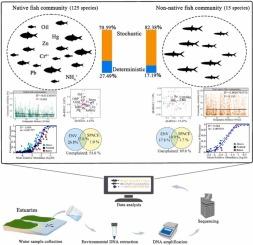通过 eDNA 代谢编码揭示人为干扰河口中本地和非本地鱼类群落对污染的不同反应
IF 11.3
1区 环境科学与生态学
Q1 ENGINEERING, ENVIRONMENTAL
引用次数: 0
摘要
了解环境污染物对河口鱼类群落集结机制的影响,对于应对这些生物多样性生态系统的保护挑战至关重要。尽管已有大量研究探讨了石油、重金属和富营养化等污染物对个体物种和种群的毒性影响,但对它们对群落组装过程的影响以及本地鱼类和非本地鱼类在元群落水平上的不同反应仍然了解不足。本研究利用环境 DNA(eDNA)代谢编码分析了中国 28 个亚热带河口的鱼类群落多样性,评估了这些污染物如何影响群落组成和组装机制。结果表明,在物种鉴定方面,eDNA的效率是传统方法的2.54倍,同时还能在河口生态系统中发现更多的非本地鱼类物种和更多样化的功能区。在本地鱼类中观察到了明显的距离衰减模式(p < 0.05),而非本地物种则表现出不明显的模式。中性和无效模型显示,与本地物种相比,非本地物种的洄游率(0.005939 vs 0.001757)明显更高,随机过程的贡献率(82.38% vs 70.59%)也更大。此外,基于距离的冗余分析(db-RDA)、方差分区分析(VPA)和相关性分析表明,本地物种受到环境因素的强烈制约,尤其是石油、汞、锌、铅、六价铬和四氧化二氮,而非本地物种则对这些污染物表现出明显的适应能力。这些发现凸显了非本地物种在环境干扰下通过不受限制的随机扩散对群落动态和组合产生巨大影响的潜力。这项研究阐明了河口环境中本地鱼类群落和非本地鱼类群落对人为压力的截然不同的生态反应,为生态系统的恢复能力提供了重要的见解,并为快速变化的沿海生态系统的生物多样性保护策略提供了信息。本文章由计算机程序翻译,如有差异,请以英文原文为准。

Contrasting pollution responses of native and non-native fish communities in anthropogenically disturbed estuaries unveiled by eDNA metabarcoding
Understanding the influence of environmental pollutants on the assembly mechanisms of estuarine fish communities is vital for addressing conservation challenges in these biodiverse ecosystems. Although significant research has explored the toxic impacts of pollutants such as petroleum, heavy metals, and eutrophication on individual species and populations, their effects on community assembly processes and the differential responses of native versus non-native fish at the meta-community level remain inadequately understood. This study utilized environmental DNA (eDNA) metabarcoding to analyze fish community diversity across 28 subtropical estuaries in China, assessing how these pollutants affect community composition and assembly mechanisms. Results indicated that eDNA was 2.54 times more effective than traditional methods in species identification, while also enabling the detection of a higher number of non-native fish species and more diverse functional guilds within estuarine ecosystems. A significant distance decay pattern (p < 0.05) was observed among native fish, whereas non-native species exhibited non-significant patterns. Neutral and null models showed that non-native species had significantly higher migration rates (0.005939 vs 0.001757) and a greater contribution of stochastic processes (82.38% vs 70.59%) compared to native species. Additionally, distance-based redundancy analysis (db-RDA), variance partitioning analysis (VPA), and correlation analyses revealed that native species were strongly constrained by environmental factors, particularly oil, Hg, Zn, Pb, Cr6+, and NH4+, while non-native species displayed notable resilience to these pollutants. These findings highlight the potential for non-native species to disproportionately influence community dynamics and assembly through unrestricted random dispersal amid environmental disturbances. This research clarifies the contrasting ecological responses of native and non-native fish communities to anthropogenic pressures in estuarine environments, offering essential insights into ecosystem resilience and informing biodiversity conservation strategies in rapidly changing coastal ecosystems.
求助全文
通过发布文献求助,成功后即可免费获取论文全文。
去求助
来源期刊

Journal of Hazardous Materials
工程技术-工程:环境
CiteScore
25.40
自引率
5.90%
发文量
3059
审稿时长
58 days
期刊介绍:
The Journal of Hazardous Materials serves as a global platform for promoting cutting-edge research in the field of Environmental Science and Engineering. Our publication features a wide range of articles, including full-length research papers, review articles, and perspectives, with the aim of enhancing our understanding of the dangers and risks associated with various materials concerning public health and the environment. It is important to note that the term "environmental contaminants" refers specifically to substances that pose hazardous effects through contamination, while excluding those that do not have such impacts on the environment or human health. Moreover, we emphasize the distinction between wastes and hazardous materials in order to provide further clarity on the scope of the journal. We have a keen interest in exploring specific compounds and microbial agents that have adverse effects on the environment.
 求助内容:
求助内容: 应助结果提醒方式:
应助结果提醒方式:


